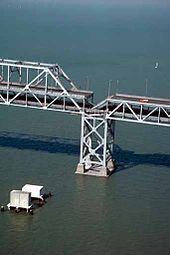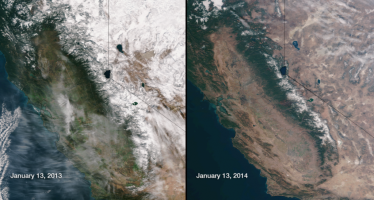Crazifornia: Still more Cali-Incompetence on the Bay Bridge
By Laer Pearce
It’s been almost a quarter century — 23 years, seven months and five days, to be exact – since the 1989 Loma Prieta earthquake knocked out a section of the eastern span of the Oakland Bay Bridge, causing one of the earthquake’s 57 fatalities.
Despite the huge chunk of time that’s passed, California is still bungling along without a safe replacement bridge in place.
Yes, the new span is supposed to be ready to open this Labor Day, Sept. 5. But whether it’s ready, and whether it’s safe, remain to be seen. And the cost? The first bid came in at $1.4 billion, and we’re at $6.3 billion today — with some potentially very expensive fix-it work ahead.
Disaster
Here’s a brief summary and timeline of the slowly unfolding human disaster that followed the natural disaster:
* After the quake, Republican Gov. Pete Wilson proposed a concrete viaduct as a replacement, which could be built cheaply ($1 billion, he thought) and safely.
* That idea was promptly shot down by haughty Bay Area leaders, who refused to accept something as pedestrian as a viaduct. (A viaduct is mundane — just several short spans tied together, getting from one side to the other without any showiness.)
* For the next 10 years, Bay Area politicians fought over an appropriate design, while the patched-together Bay Bridge remained vulnerable to the next big quake.
* It was decided the western portion of the eastern span (leaving Yerba Buena Island towards Oakland) would be a “signature structure” and the rest would be … a viaduct. A design contest was held, judged by the Engineering and Design Advisory Panel (EDAP) of the Metropolitan Transportation Commission. You might be shocked to learn that many of the design finalists were proposals submitted by the very firms that employed EDAP members, and the ultimate winner was an EDAP member’s entry. “This posed a serious conflict of interest,” said one analysis. Indeed, especially since the selected design was more expensive than the alternatives.
* The mayor of Oakland at the time, Jerry Brown, protested mightily because the signature structure was as far away from Oakland as it possibly could be. He said the design “speaks of mediocrity, not greatness.”
* Gov. Gray Davis put an end to the squabbling and moved the selected design forward, signature span, viaduct and all.
* When a single submitted construction bid was opened in September 2004, state officials were surprised to see it was $1.4 billion, about twice what the number-crunchers at Caltrans thought it would be.
* Gray was gone and Arnold was in, and in December 2004 Gov. Schwarzenegger canceled the contract, saying it was too expensive. Instead, he wanted an all-viaduct design. Ghosts of Pete Wilson!
* Signature span hawks fought back in a battle of conflicting cost estimates until, in November 2005, a “compromise” was reached that returned the signature span. It’s not clear to me what the countering half of this compromise was, but the cost of the delay is clear enough: as much as $400 million. That’s a small price to pay for great bridge architecture, right?
* Construction got under way, and a few months later, in April 2005, welds on the bridge were called into question.
* On October 27, 2009, a crossbar and two tension rods collapsed, dumping 2.5 tons of debris onto the upper deck roadway during the evening commute. One car and a delivery truck were struck, but no one was killed. The bridge was closed to traffic in both directions for six days.
* In November 2009, a cracked eyebar was discovered that would have closed the bridge had it not been under a temporary construction closure already.
* As detailed in my book “Crazifornia,” in November 2011 Caltrans got caught covering up that one of its staffers had fabricated the results of tests on the integrity of Bay Bridge concrete pours, including pours of the structure supporting the massively heavy signature span tower. A report on what this means to the bridge’s integrity is due out in Spring 2013 — any day now.
* In March 2013, three big bolts (3 to 19 feet in length) that connect portions of the bridge deck to concrete columns failed load tests. Subsequently, 30 of the bridge’s 96 bolts failed the test. Some of these bolts cannot be removed because the bridge has been built around them.
* Also in March, 32 galvanized steel rods snapped when being tightened. There are 1,900 such rods on the new bridge. The Sacramento Bee reported Caltrans justified use of galvanized steel rods based on their successful use on the Richmond-San Rafael Bridge, but provided this quote from a corrosion expert: “Low stress on [the Richmond-San Rafael Bridge] means nothing for the Bay Bridge, where the stress is so beyond the other application.”
* And just this last Saturday, the Sacramento Bee reported that incompetent construction and bureaucratic ineptitude have led to rust forming on steel tendons that are critical to the bridge’s safe operation. First, Caltrans did a duct tape fix (Really, with actual duct tape!), then they attempted to minimize this problem. Metallurgists expert in how steel performs under corrosive conditions have declared the rust to be a very big deal, however.
So, what did we get for our quarter century of waiting and 450 percent cost overrun? A bridge with a design that satisfies no one, that may not have met the basic requirement that it be safe, and that certainly will have much higher ongoing maintenance and repair costs than it should have.
Welcome to Crazifornia. And thank you, Caltrans.
Laer Pearce, a 30-year veteran of California public affairs, is the author of Crazifornia: Tales from the Tarnished State.
Related Articles
Green Catch-23 Hurts Hydro Power
APRIL 19, 2011 By WAYNE LUSVARDI If a Catch-22 is a choice between two equally undesirable alternatives, California’s mandate to
New energy secretary could boost CA oil production
Feb. 8, 2013 By Chriss Street President Obama’s expected naming of Ernest J. Moniz as the next secretary of energy
Feinstein attacks environmentalists on drought
On May 15, Sen. Dianne Feinstein, D-Calif., didn’t pull any punches about her recent attempt to push her drought bill through




